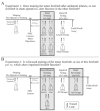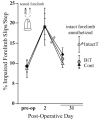Maladaptive effects of learning with the less-affected forelimb after focal cortical infarcts in rats
- PMID: 18054917
- PMCID: PMC2733868
- DOI: 10.1016/j.expneurol.2007.10.010
Maladaptive effects of learning with the less-affected forelimb after focal cortical infarcts in rats
Abstract
It is common following stroke to focus early rehabilitation efforts on developing compensatory use of the less-affected body side. Here we used a rat model of focal cortical infarct to examine how motor skill acquisition with the less-affected ("intact") forelimb influences sensorimotor function of the infarct-impaired forelimb and neural activity in peri-infarct cortex. Rats proficient in skilled reaching with one forelimb were given focal ischemic lesions in the contralateral sensorimotor cortex (SMC). Recovery in this forelimb was tested following a period of reach training focused on the intact forelimb or control procedures. Quantitative measures of the cumulatively expressed transcription factor, FosB/DeltaFosB, were used to assay intact forelimb training effects on neuronal activity in remaining SMC of the infarcted hemisphere. Intact forelimb training worsened behavioral recovery in the impaired forelimb following unilateral focal ischemia. Furthermore, it decreased neuronal FosB/DeltaFosB expression in layer II/III of peri-infarct SMC. These effects were not found in sham-operated rats trained sequentially with both forelimbs or in animals receiving bilateral forelimb training after unilateral infarcts. Thus, focused use of the intact forelimb has detrimental effects on recovery of impaired forelimb function following a focal ischemic injury and this is linked to reduced neuronal activation in remaining cortex. These results suggest that peri-infarct cortex becomes vulnerable to early post-stroke experience with the less-affected forelimb and that this experience may drive neural plasticity here in a direction that is maladaptive for functional outcome.
Figures






References
-
- Adams FS, Schwarting RK, Huston JP. Behavioral and neurochemical asymmetries following unilateral trephination of the rat skull: is this control operation always appropriate? Physiol Behav. 1994;55:947–952. - PubMed
-
- Adkins DL, Bury SD, Jones TA. Laminar-dependent dendritic spine alterations in the motor cortex of adult rats following callosal transection and forced forelimb use. Neurobio Learn Mem. 2002;78:33–52. - PubMed
-
- Adkins-Muir DL, Jones TA. Cortical electrical stimulation combined with rehabilitative training: enhanced functional recovery and dendritic plasticity following focal cortical ischemia in rats. Neurol Res. 2003;25:780–787. - PubMed
-
- Allred RP, Jones TA. Unilateral ischemic sensorimotor cortical damage in female rats: Forelimb behavioral effects and dendritic structural plasticity in the contralateral homotopic cortex. Exp Neurol. 2004;190(2):433–445. - PubMed
-
- Allred RP, Maldonado MA, Hsu JE, Jones TA. Training the “less-affected” forelimb after unilateral cortical infarcts interferes with functional recovery of the impaired forelimb in rats. Restor Neurol Neurosci. 2005;23(5–6):297–302. - PubMed
Publication types
MeSH terms
Substances
Grants and funding
LinkOut - more resources
Full Text Sources
Miscellaneous

